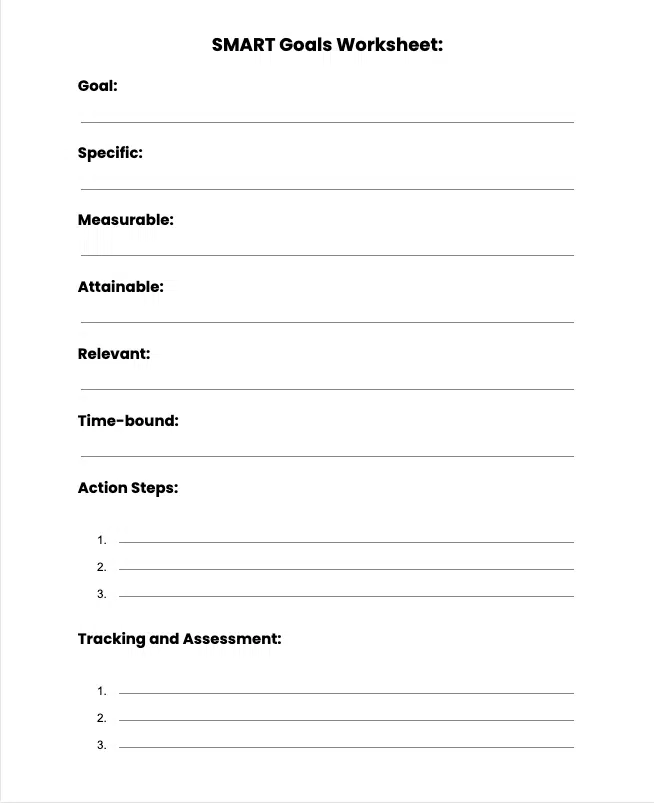What is a SMART Goal?
The definition of a SMART goal refers to specific, measurable, attainable, relevant, and time-bound goals that help individuals and organizations achieve their objectives. The acronym ensures that goals are clearly defined and achievable within a realistic timeframe.
- Specific: Clearly defined and well-stated
- Measurable: Quantifiable or capable of being tracked
- Attainable: Realistic and achievable within the given constraints
- Relevant: Aligned with an individual’s or organization’s priorities and purpose
- Time-bound: With a set deadline or time frame for completion.
Why Are SMART Goals Important?
SMART goals are essential because they help align individual and departmental objectives with the overall goals and strategy of the organization. Having clear, specific, and measurable goals, employees can understand their role in achieving the organization’s vision, focus their efforts, and track their progress in improving and developing their careers. In addition, managers often use them to establish employee performance targets that can be part of the employee’s performance reviews. This, in turn, can improve motivation and performance, leading to better outcomes for the organization.
SMART goals also provide a framework for regular performance evaluations and goal-setting, allowing organizations to track progress, identify areas for improvement, and adjust their strategies as needed. This helps organizations maintain a clear direction, avoid distractions and misalignments, and stay on track to achieving their long-term objectives.
Why are SMART goals essential at large organizations?
In large organizations, SMART goals facilitate effective communication and collaboration between departments and teams, ensuring everyone is working towards a common goal. This can help improve cross-functional coordination, reduce duplicated efforts, and enhance organizational efficiency.
Overall, using SMART goals helps establish a culture of accountability, clarity, and continuous improvement, enabling organizations to achieve their strategic objectives and deliver better results.
How Can SMART Goals Help Employees?
The SMART goals guide is a systematic and highly structured framework with precise goals. Individuals can confirm the alignment of priorities and resources by working through each step.
The role of this guideline is to:
- Give an objective.
- Facilitate planning.
- Identify strengths and weaknesses.
- Help employees achieve their professional goals.
- Help employees stay focused, motivated, and disciplined.
- Challenge individuals’ comfort zone.
Leaders can use SMART goals even when using other models. For instance, managers can use it while motivating employees with the GROW Coaching Model. Here’s a quick explainer of the GROW Coaching Model.
SMART Goals Explained
SMART goals answer the five W’s; who, what, where, when, and why. The acronym is specific, measurable, achievable, relevant, and time-bound.
1. Specific Goals
A specific goal focuses on a particular area rather than a vague idea. Narrow-down objectives hey help individuals plan more effectively.
Workers should answer the following questions when setting specific goals:
- Who is responsible for it?
- What will be accomplished?
- Where is it located?
- Why is this goal important?
- Which actions and resources will be needed?
Employers and employees stay on the same page with specific goals. Managers can train teams to set better goals. Some leaders exchange “specific” for sensible, significant, and straightforward.
2. Measurable Goals
A measurable goal is quantifiable so that individuals can track progress. Measurable objectives are one of the essential aspects of effective goal setting. It also gives individuals the opportunity to reevaluate the goal if needed.
Employees should answer the following questions to set measurable goals:
- What data or evidence will measure the goal?
- How will participants know the goal is accomplished?
- What is the measurement method?
Organizations and workers may use timers or tracking software. Metrics give employers and employees the ability to see growth. Some leaders exchange “measurable” for motivating since a finishing line is a highly inspiring visual.
3. Achievable Goals
An achievable goal is attainable. High expectations are commendable, but an unreachable objective is demotivating. Individuals tasked with unachievable goals may need more time to start.
Individuals should answer the following questions to verify achievable goals:
- Is the goal doable?
- Do participants have the necessary skills and resources?
- How can the goal be accomplished?
All goals have hurdles. Yet, employees must be able to overcome them. Workers should be conscious of goal-setting that relies on someone else. For instance, getting a promotion is dependent on the manager’s decision. However, completing training to be eligible for the promotion is within their power.
Some leaders exchange “achievable” for assignable, attainable, agreed, action-oriented, ambitious, or aligned with corporate goals.
4. Relevant Goals
A relevant goal relates to current and long-term plans. It should be pertinent to the organization’s objectives. Even personal and professional goals can align with the employer’s overarching mission.
Workers should answer the following questions when determining relevant goals:
- How does the plan align with broader goals?
- Why is the result significant?
- Is this the right time?
- Are the participants the right people?
Some leaders exchange “relevant” for realistic, resourced, reasonable, or results-based.
5. Time-Bound Goals
A time-bound goal has a deadline. A due date generates incentives through time constraints. Additionally, it is part of progress tracking.
Big goals can have multiple deadlines. Splitting a significant objective into smaller ones can make them more manageable. Numerous due dates are particularly beneficial for long-term goals.
Employees should answer the following questions to set time-bound goals:
- What is the timeframe for accomplishing the goal?
- For example, can this be done in six weeks or six months?
- What can be done today or this week?
Some leaders exchange “time-based” for time-related, time-limited, time-based, time-oriented, timely, or time-sensitive.
6. SMARTER Goals
Management can modify the SMART goals framework by adding “ER”. Managers evaluate and readjust employees’ objectives if a contingency plan is needed.
Lack of flexibility is one of the drawbacks of the SMART goal framework. The ability to evaluate and readjust methods prevents organizations from hitting a wall if they miss their target. Readjusting goals doesn’t mean starting over. Instead, it may require leaders to try different approaches.
SMART Goals Coaching
A good coaching objective begins by identifying a specific goal. This goal is the coaching focus for the team or member, leading to higher performance. The following are three types of coaching objectives:
- Knowledge – Coaching can develop employees’ knowledge or help them build their existing know-how to higher levels. Every job requires employees to know certain information necessary to complete assigned tasks.
- Skill – Coaching can teach or improve an ability vital to do a job. Employees can develop or enhance skills to complete essential tasks.
- Behavior – Coaching can help employees master or demonstrate critical behaviors. Behaviors define the way workers conduct themselves on the job. Coaching models and provides feedback that helps them increase their ability and desire to present the right behaviors.
A great coach is a partner who helps individuals improve their performance or achieve their goals. A coach differs from a mentor. A mentor has specific answers based on their experience. But a coach has the skills to guide and empower participants.
Organizations can coach managers to train direct reports on SMART goal-setting.
SMART Goals Examples for Work
Here is an example of a SMART-goal statement:
The goal is to [quantifiable objective] by [timeframe or deadline]. [Key players or teams] will accomplish this goal by [steps needed to achieve the plan]. Completing this goal will [result or benefit].
Professional Goals
Individuals can focus on their professional improvements. These workplace-related goals often center on becoming more efficient at their job or career success. Some personalized professional plans include:
- Learn to practice mindfulness daily for a month to improve task attentiveness and cease distractions.
- Complete a manager training course biannually to develop and improve leadership skills that motivate teams.
- Improve product understanding by creating and delivering two product projects by the end of the quarter.
Professional goals can include performance targets and the development of soft goals. For example, managers often set performance targets to increase employee productivity. And soft skills can improve their time management, decision-making, and other personable skills.
Team Goals
These goals focus on the success of the team as a whole. Team goals include meeting specific sales quotas or achieving project milestones. Some team goals include:
- Prepare for a product launch by listing activities, tasks, and deadlines.
- Ensure that at least 90% of the team completes safety training by the end of the next quarter.
- Increase brand awareness through advertisements, posts, and events that equate to 100,000 new followers in six months.
Getting everyone on the same page is one of the benefits of the SMART framework. It also helps keeps teams inspired.
SMART Goals Worksheet Example
Objectives are specific, short-term targets with measurable results. Goals are the desired long-term outcomes. The SMART guideline helps individuals form objectives to achieve longer-term goals.
When completing a SMART goal worksheet, employees need to:
- Flesh out the details.
- Determine important metrics.
- Align with the company’s goals.
- Commit to a timeline.
Goal Title:
S – Specific: Clearly define the goal and what needs to be accomplished. Think about who, what, where, and when.
M – Measurable: Determine how the goal will be tracked and measured.
A – Action: Make sure the goal is realistic and attainable, given the resources and time available. What will you do to achieve your goal?
R – Relevant: Ensure that the goal aligns with the organization’s overall objectives and the employee’s role. (Could be a check box)
T – Time-oriented: Establish a deadline for achieving the goal. How long will it take to complete?
SMART Goals Worksheet:
Note: This is just a sample worksheet and can be modified to fit the organization’s and employees’ specific needs.












